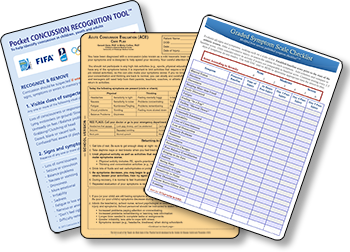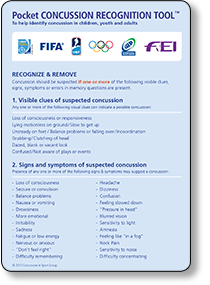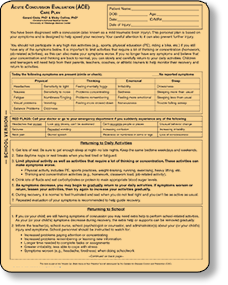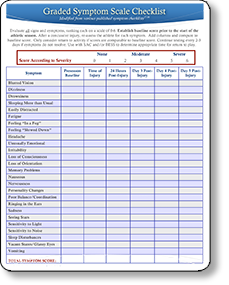Tools
Select each tab above for more information. | |
 |
TOOLSMany tools are available to aid in recognition, |
POINT OF INJURY:
Symptom Recognition in the Initial Evaluation
Having the means to recognize concussion symptoms and signs can help clinicians properly diagnose any insult to the brain caused by the impact. Proper diagnosis is the first step to proper concussion management. There must be a mechanism of injury, together with rapid onset (within 24 hours) of ‘typical signs and symptoms. The best practice is to assess balance, cognition, symptoms, oculo-motor signs; Use standardized tools in the correct administration (within 48 hours); Rule-out alternative diagnoses; Diagnosing after 48 hours is difficult; It is also important to gather information of the patient and injury from all available sources, particularly important if you didn’t witness the injury. (See Berlin 2016 for statement about Sideline Evaluation). Pocket Concussion Recognition Tool |
 |
CONCUSSION MANAGEMENT:
Planning Recovery and Return
 |
The proper management of the injury includes, in part, tracking the resolution of symptoms following a concussion. While the resolution of symptoms should not be the sole basis for determining the return-to-activity status of a concussed patient, it should be utilized as part of a more comprehensive clinical decision-making process. To manage concussion care, you will need a plan for return to activity or Return to Play. Acute Concussion Evaluation (ACE) Care Plan |
MOVING TOWARD RECOVERY:
Tracking Symptom Resolution
Another method of monitoring the symptoms during the recovery described in the ACE Care Plan is to use a graded symptom checklist that allows for multiple days to be tracked. Bear in mind that return to activity should not be based solely on the self-reported resolution of symptoms. Symptom scales provide a valuable method for monitoring the progression of concussion symptoms over several days. Graded Symptom Checklist |
 |
